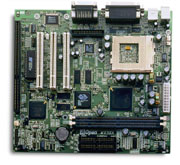AOpen MX3ZA i440ZX microATX Socket-370
by Mike Andrawes on June 3, 1999 11:44 PM EST- Posted in
- Motherboards
As the second largest motherboard manufacturer in the world, behind just Intel, AOpen certainly must be doing something right. OEM business is the key to such high sales, but sometimes, what an OEM wants is not what the tweaker wants. In AOpen's case, they've always done an excellent job of carefully balancing the two very different sets of requirements. What you end up getting from them is very fast, stable, and well built board.
One of the things that OEM's love is the chance to cut costs and that often means using the most integrated solutions possible. Of course AOpen is there to fill that need for OEM's as well, but such solutions can be useful to the do-it-yourselfer as well. AOpen's MX3ZA is such a board featuring onboard audio and sound and the ability to another low cost option - Socket-370 CPU's. Let's see how it fares...
New Anand Tech Report Card Rating 88/B
Do not compare newer ratings to older ones, the newer ratings are much more aggressive
| CPU Interface | Socket-370 |
| Chipset | Intel i440ZX |
| L2 Cache | N/A (on-chip) |
| Form Factor | microATX |
| Bus Speeds |
66 / 75 / 83 |
| Clock Multipliers | 1.5x - 8x |
| Voltages Supported | Auto Detect |
| Memory Slots | 2 168pin DIMM Slots |
| Expansion Slots |
0 AGP Slots |
| BIOS | Award 4.60PGMA |
The Good
The MX3ZA looks like a typical AOpen motherboard at first glance - high quality construction, big capacitors, and of course the AOpen logo right in the middle of the board. But where'd the AGP slot go? Then the ATI Rage Pro Turbo chip pops out at you to remind you of the integrated AGP video that takes that slot's place - quite a bit like Shuttle's MB11 actually. Then there's the extra ports on the back of the board for sound and a joystick, powered by the ESS Solo-1 PCI audio controller.
The Rage Pro Turbo get its own bank of 8MB 100MHz SDRAM, so no memory and performance sapping unified memory architecture here. That 8MB should be plenty to handle most 2D tasks. ATI's Rage Pro Turbo is a tried and true chipset, with drivers available for just about any operating system, including Linux, BeOS, and OS/2. Of course for Windows gaming, the Rage Pro Turbo still lacks a really good OpenGL ICD.
The onboard ESS Solo-1 is a PCI based solution that does a good job at providing basic audio functionality. CPU utilization is low thanks to the PCI interface. AOpen also wisely made the sound only take up one IRQ, unlike some other solutions featuring the same chip that take two. Unfortunately, that IRQ is the same one taken by the USB controller, whose IRQ cannot be disabled.
With this sound selection, one of the few PCI soundcards with Linux support (albeit beta at the time of review), this board just needs a CPU and RAM (and maybe a network card) to become a full fledged and fairly powerful Linux box. Although not exactly the ideal setup for a hardcore gamer, the same could be done under Windows 9x or NT for a basic, but complete workstation.
AOpen decided to go with a 3/1/0 (PCI/ISA/AGP) expansion slot configuration that isn't too bad for a microATX board, although one more ISA or (preferably) PCI slot could have been squeezed in. Of course, the burden of expansion is eased a bit by the onboard video and sound, which each include a jumper for manually disabling them. Fortunately, the lone ISA slot is not shared with any PCI slots, so you'll have all of them available for expansion purposes. Two DIMM slots handle memory expansion duties - typical stuff for an i440ZX board. Although the picture above does not show it, the i443ZX AGP controller is covered by the almost "traditional" green heatsink and is adorned with the AOpen logo.
The microATX specification is followed fairly closely in terms of layout. The HDD connectors are located where they should be, right at the front of the board, so that thsee cables are not forced to run over the CPU and/or memory, minimizing cable clutter. The ATX power connector is not in the ideal location, but is far enough forward so as to not impede airflow to or from the CPU. Ten beefy 1500uF capacitors surround the CPU socket, but still provide room for a normal sized heatsink to be attached easily. Two more of those capacitors are located around the DIMM slots in addition to a number of smaller valued ones spread all over the board. Two 3 pin fan connectors are available for using monitored fans - one by the CPU socket and one right in front of the ISA slot that could get in the way of an ISA card. AOpen is still including a 2 pin fan connector for some of those older Socket 7 CPU fans that can be mounted just fine on a Socket-370.
Marring the otherwise good layout, is the placement of the FDD connector at the back of the board, forcing that cable to run over the memory, and possibly the CPU, to reach its destination. That cable clutter makes it difficult to work inside the complete system and also obstructs air flow somewhat. The board uses a standard microATX mounting format and should fit just fine in any microATX or ATX case.











0 Comments
View All Comments